Chris & Allyson vs. Alaska (2016)
Chapter Three: Icy Strait Point
Gertrude Stein once said of Oakland that "There's no there there." Her head would have exploded at Icy Strait Point.
The dock has room for just one ship, and the structure itself is more or less a nicely built boardwalk. (Before 2016, there was no dock, and you ferried to shore on tiny ships.) The dock isn't attached to a city; instead it backs up on a small visitor center. There are none of the usual cruise port stores, where you buy the sunglasses and Tanzanite jewelry you need to look great at a house party in Little Italy.
There are trees, and a coastline, and a few modest buildings clustered together. The only thing to do is "excursions," and they schedule your visit so that you're at Icy Strait Point all friggin' day. When you're reading about it months in advance, it seems like an elaborate scheme to get you to stay on board and do spa treatments at $150 a pop. It turned out to be one of the greatest stops on the entire vacation.
The Millennium rolled up to Icy Strait Point (on beautiful Chichagof Island!) at around 7 a.m.. We woke up right around that time, to have breakfast on the ship. (We ran into kayaking buddies Brenda and Yuval and compared notes on the day ahead. They seemed cool.)
Walking off the ship, we spotted two bald eagles in the trees right next to the dock. Since this was only the fifth day of vacation, bald eagles still seemed impressive. We opted to try the "nature trail" marked at the end of the dock; it's a glorified quarter-mile path through some very tall trees, and it ends right at the visitor center. We WANTED Tanzanite jewelry, but as there was nowhere to buy it, we decided to check in for the day's activities.
The sales pitch at Icy Strait Point is that it's the "natural" cruise port. With that in mind, we had settled on some of the most natural excursions on the menu: whale watching, and the completely natural experience of zip-lining. What we didn't know in advance was that they wouldn't let us do either one until the afternoon. Fortunately, we're young and have functioning legs, so we made our own morning excursion.
It isn't quite fair to say that there's "nothing" at Icy Strait Point. In spirit, it's the business district for Hoonah, a town of about 750 year-round residents. Most of them are Tlingits (i.e. Native Southeast Alaskans), and Icy Strait Point is their way of taking the power back. In the early 20th century, the town relied on a fish cannery for most of its jobs, but that went away by the 1950s. In the early 21st century, it was decided that the old cannery space was probably the last best hope for the town's survival. The natives collectively own the "Huna Totem Corporation" to further their interests. The cruise terminal is owned by the corporation. The excursions are operated by the corporation. The money you spend at Icy Strait Point, for the most part, goes to the corporation. So you can zipline AND assuage a little white guilt at the same time.
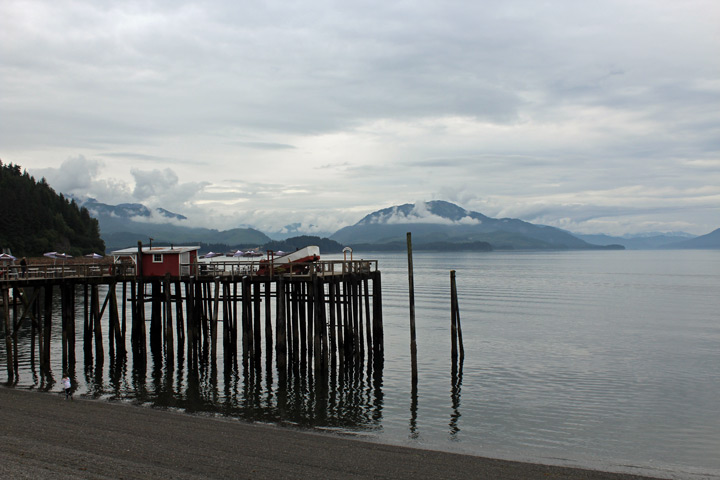
Welcome to Icy Strait Point and Hoonah, where going native means something.
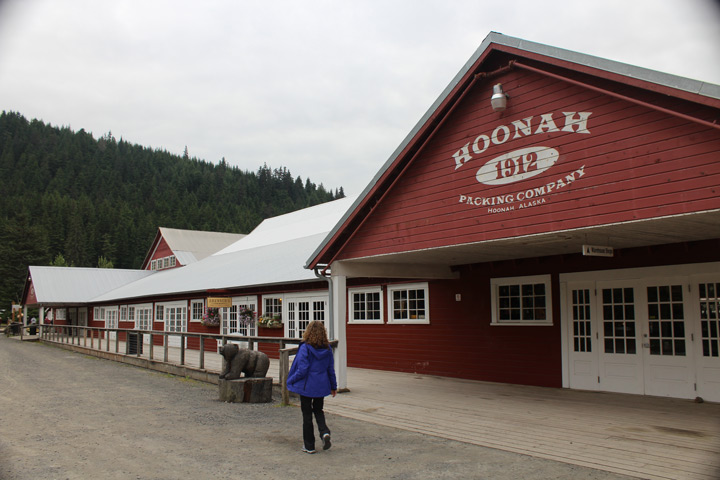
The cannery still looms large in the cultural memory of Hoonah and the Tlingit.
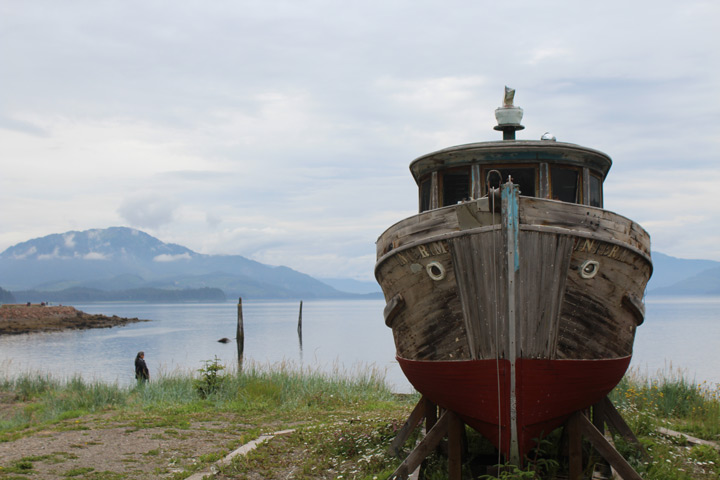
A scene from the walk between the dock and Hoonah proper.
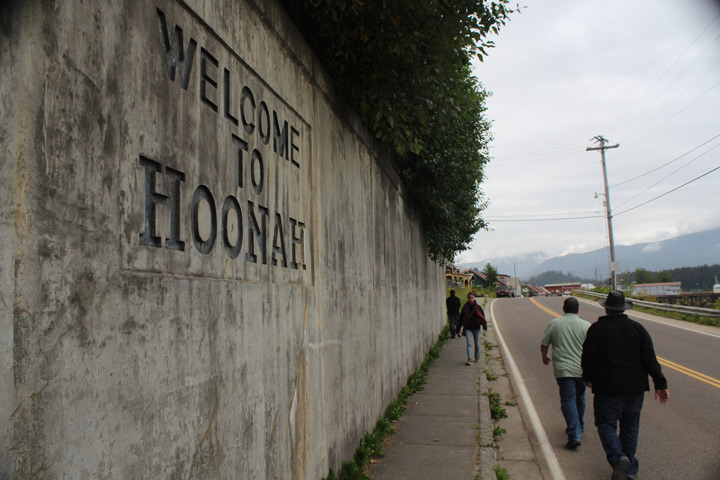
Just a bit removed from the cruise ship dock, the town of Hoonah is a slice of Sealaska reality.
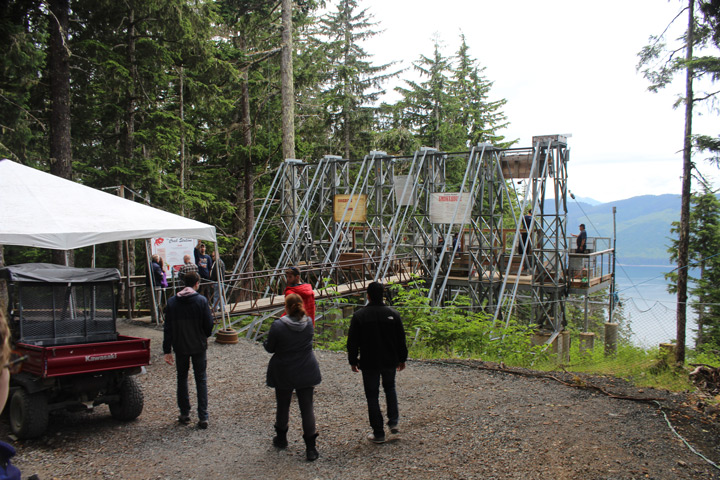
At the top of the Ziprider -- one of the coolest zipline experiences.
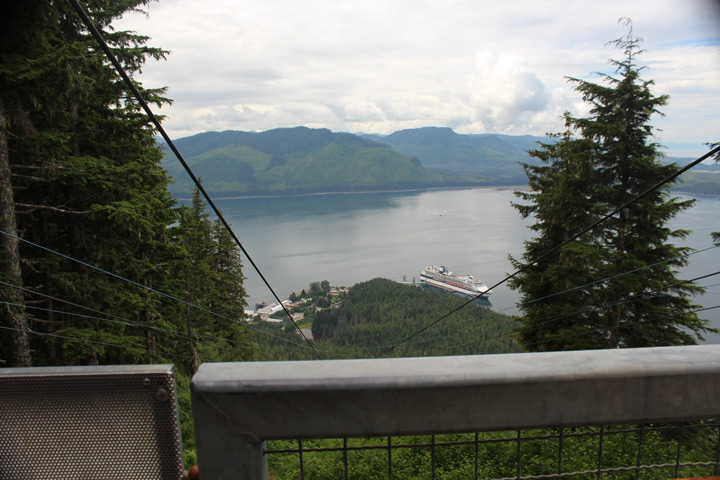
The Ziprider takes you down to the dock -- a drop equivalent to the height of the Empire State Building.
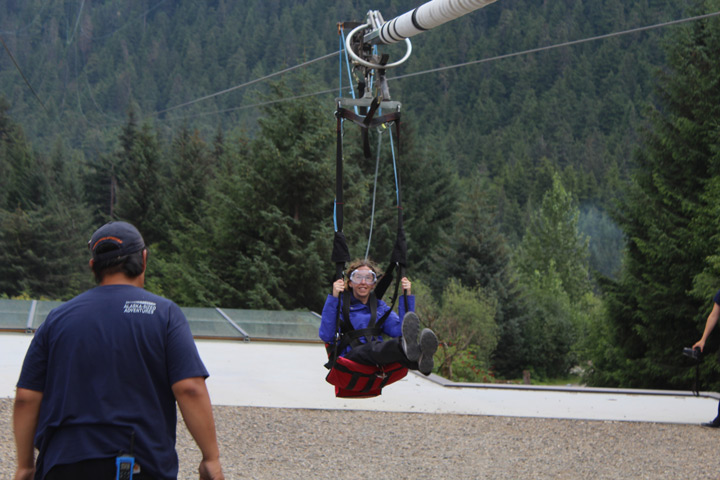
Allyson coming in for a landing.
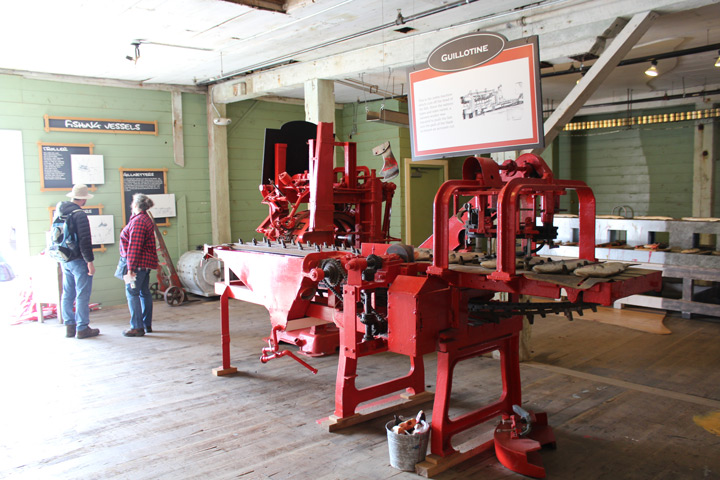
The "guillotine," a little piece of history from Hoonah's canning industry.
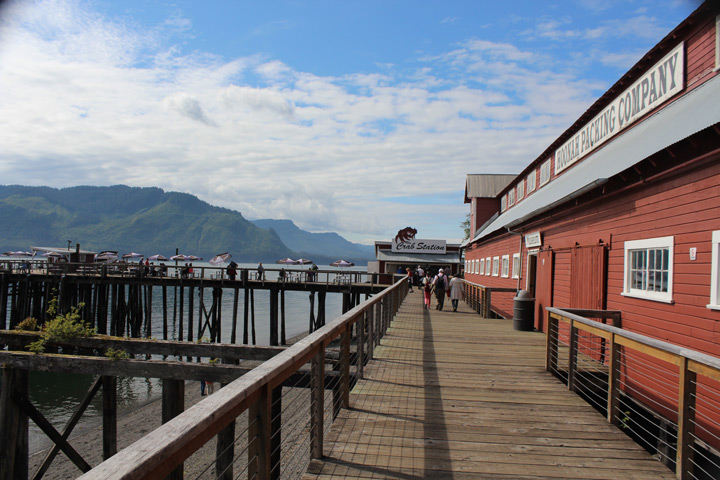
Hoonah's scenic (and humble) waterfront.
Hoonah proper is about a mile and half from the cruise dock, and there's a very scenic sidewalk leading there. You pass the town’s dry dock on your way to the residences, so Hoonah has the classic Alaskan combo of beat-up looking boats and beat-up looking houses. Logically, every Alaskan town should be rough around the edges. Living in Alaska is expensive, and it means dealing with awful weather eight months out of the year, plus limited options for employment.
But towns like Hoonah still radiate civic and cultural pride. (For example, there's a pavilion on the main street where people gather to make traditional dugout canoes.) Every cruise ship dumps more strangers into the town than the actual population of the town, but the residents are gracious about the intrusion. It probably helps that the strangers spend money, but in America you have the option of being completely ungracious while taking people's money. New York City has been doing that for years.
We had some pleasant conversation on our way back to the visitor center, strolling through a light drizzle. Writing about it four months later, I won't pretend to remember exactly what we talked about. But knowing my wife, it was some combination of these subjects:
1) What about bears? Seeing bears was the only thing that could make our vacation a true success for Allyson, and in the middle of the fifth day, we still hadn't seen a bear. There was a "bear watch" excursion at Icy Strait Point that we passed up, and the what-ifs were probably killing Allyson at this point.
2) What if we don't see whales? Icy Strait Point has a reputation (at lease on cruise ship review sites) for great whale-watching. But if you've ever talked to people about whale-watching, then you've heard at least one story about a six-hour trip in 18-foot seas that are completely devoid of whales.
3) How do people live here? Allyson comes from Queens and has spent her entire life living in cities. She is not even remotely a snob, but small towns are an abstraction to her. The thought of anyone existing in a place like Hoonah is on par with dragons or leprechauns.
4) Extreme satisfaction that she had successfully prepared for the weather and wasn't too put off by a light drizzle.
Amazingly enough, we didn't discuss the odds of dying on our next activity. We stopped for a quick lunch when we got back to the old cannery complex. And then we checked in for the zip rider.
There's nothing all that "authentic" about zip lining. No indigenous people hunted deer by suspending steel cables from trees so they could fly after them. The human spirit should probably be satisfied with standing in the mighty forest, or walking through it. But walking stopped being a cool American thing somewhere around 1955, so we found a way to sex up the woods.
The zip rider was no ordinary zip line. The top of the zip rider is 1,300 feet above the water. (Comparable manmade structure? The Empire State Building.) The line is just over one mile long. You can reach a speed of 60 miles per hour, and you're about 300 feet above the ground for most of the ride. There are also six lines going at the same time, so you're gliding in formation -- like if the Blue Angels were actually a group of cruise ship patrons blessed with the power of human flight. You don't really need an "authentic" experience if you think your mind is going to be blown all over a one-mile stretch of mountainside.
We were both very excited about it, and after a weigh-in we were put on a school bus and shuttled to the top of the mountain. (Any activity that requires a weigh-in is guaranteed to be fun, or deadly, or both.) This took about 40 minutes, and it was actually kind of scenic. The road has lots of switchbacks, so you're constantly getting views of Icy Strait and the coastline below. We also got a show from driver Jimmy Duncan, a Tlingit who passed around his personal photo albums (with some excellent blizzard photos) and talked about day-to-day life in Hoonah. There was a tantalizing amount of bear poop on or near the road, but sadly no bears were seen. While in Alaska, you will be alternately excited by and terrified by poop, depending on whether you are in a vehicle or on foot.
Jimmy dropped us off at the top of the mountain, and we walked a short path downhill to the launch pad -- six gates, like the starting line at the Kentucky Derby, where you are attached to a harness and put in the ready position. Once you're strapped in -- on a zip rider, you're dangling from the line and not holding on to anything -- you brace your feet on a metal gate. Then you have a few seconds to pray to whatever god you believe in. Then they open the gate.
The first thing you notice is that the view is stunning. You're looking straight down the line at the cruise ship, and Icy Strait, and some beautiful scenery. You're above some enormous and beautiful trees.
The second thing you notice is that the cruise ship is getting much bigger, quickly. You can hit speeds of 60 mph on this particular zip rider, if you're heavy enough for a gravity assist and you do the right things with your hands. Because you're flying fast enough, your arms act like rudders, and you can spin 360 degrees if you want to. Or, in my case, if you aren't very good at controlling your body, you'll spin around anyhow. The zip rider isn't a race, but in the early stages, the 200-pound redhead was winning. As my body spun to face back up the mountain, I could see that 100-pound Allyson had fallen about 50 yards behind everyone else. This made me laugh, and it was almost disappointing to spin out of control again and face back down the mountain.
Near the bottom, you slow down as the line levels out, and the ride ends when your harness plows into a bunch of shock-absorbing springs. An attendant had me out of my harness and on the ground a few seconds later. Because Allyson is so ridiculously tiny, I still had enough time to unzip my jacket, take out my camera, turn on my camera, aim it and take pictures of Allyson finishing a good 20-30 seconds behind everyone else. Technically, she got more ride for her money than anyone else. We've experienced this before. Once, when riding a long gravity line in West Virginia, Allyson's body weight wasn't enough to overcome the friction on the line. She stopped about 2/3 of the way down and had to be towed to the finish by an attendant with a pole, while I took pictures and laughed. She at least made it to the end this time, and we were both laughing. But I'm pretty sure I was laughing harder.
Because we were jacked on adrenaline, it didn't seem like the worst idea to buy the overpriced souvenir photos. And as the adrenaline started to subside and we realized there was more time to kill before whale-watching, I decided it was time for a beer.
The Huna Totem Corporation anticipated this, because the entrance to the Duck Point brewery is about 100 feet from the zip rider exit. The Huna Totem Corporation seems to anticipate everything, because they put together a very nice entertainment complex that hasn't sacrificed authenticity for volume. Duck Point is a nice, regular bar that has a great outdoor patio overlooking the very calm water. It's a great setting to have a drink, and in the best case scenario you might see some marine mammals doing their thing while you relax. We didn't see any animals, but we were entertained by an elderly white woman making a phone call and trying to clear up some kind of lease problem with a beach home in Maryland. She was from the school of people who talk louder the worse the connection gets, and at one point she explained to someone that she was "out of the country." She will live forever in our memories, no matter what country she thinks she's in.
As to the rest of the complex: The old salmon cannery has been converted into a museum and native-owned shops. The exhibits detail the importance and science of salmon fishing. (I will not recount those things here, because that's why the good lord invented Wikipedia.) The exhibits also reveal the history of Hoonah, which is remarkable and slightly terrifying. In 1944, some people smoking salmon at their home accidentally let the fire spread and consume almost the entire village. The homes were destroyed, and so were many Tlingit cultural artifacts. The culprits belonged to a particular clan, and the leader of that clan realized they would be forever shamed by the destruction. To atone, he gathered his own clan's artifacts … and sat in a burning building with them until he and artifacts were destroyed. Yikes.
There's also a recreation of a mid-20th-century canning line, complete with machines that seem to come from a Bugs Bunny cartoon. You can take in the majesty of the smash-o-matic, then buy a souvenir magnet a few feet away. Allyson doesn't eat fish, and this exhibit probably chiseled that lifestyle choice in stone. More salmon for the rest of us!
The museum was fun, but we did have bigger fish to fry. Or technically, big mammals. At 4:15 we boarded a nice little ship to embark on a little whale watching.
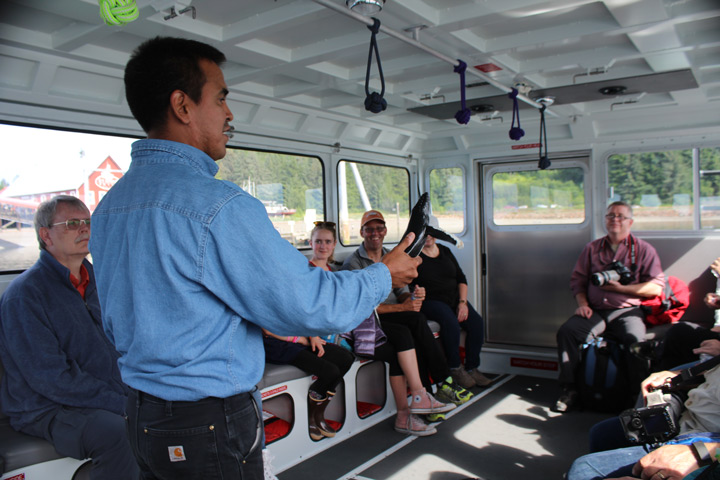
Getting ready for a whale-watching expedition.
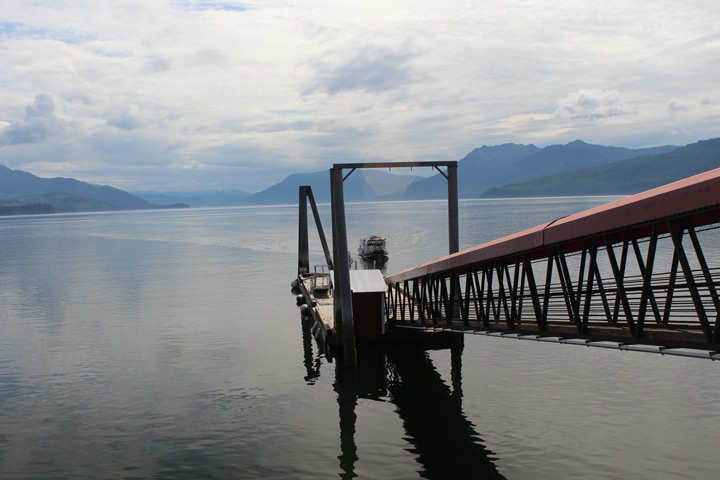
The departure point for whale-watching boats at Icy Strait Point.
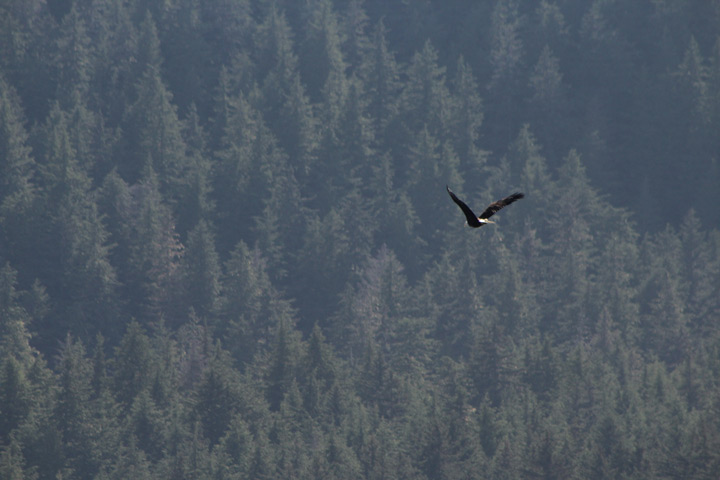
Another eagle, from when we still weren't sick of eagles.
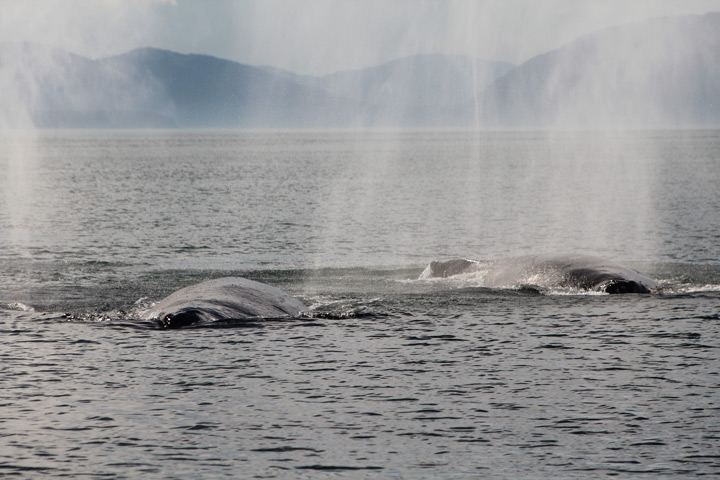
Humpback whales catch their breath in the waters of Icy Strait Point.
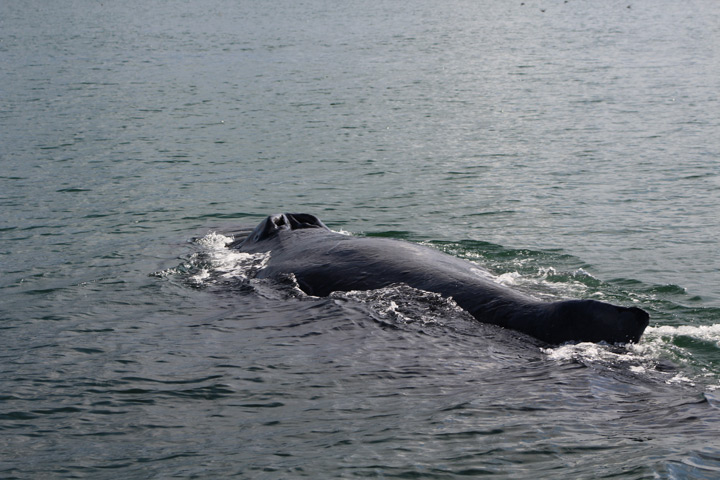
Everybody's humpin' around.
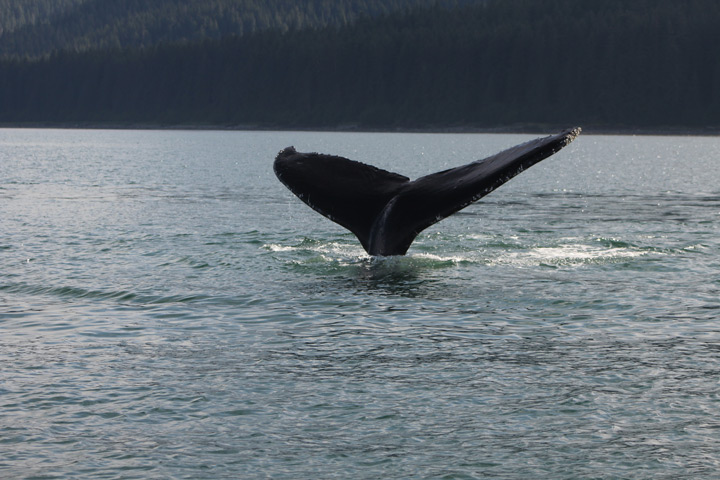
A humpback, starting to dive in search of food.
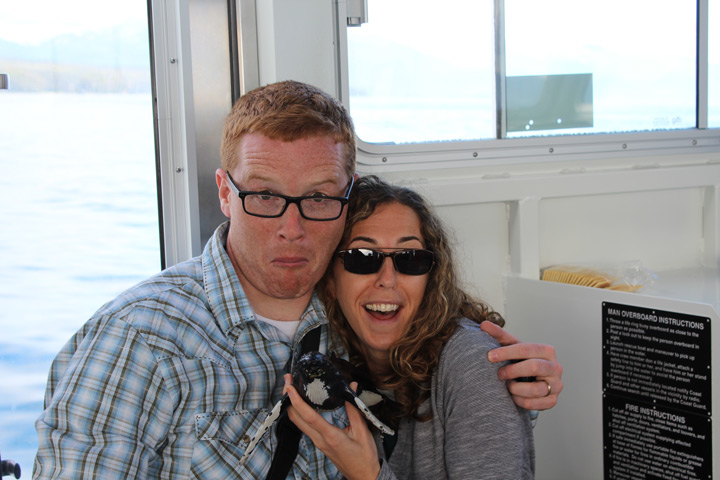
The closest we got to a whale. Icy Strait Point.
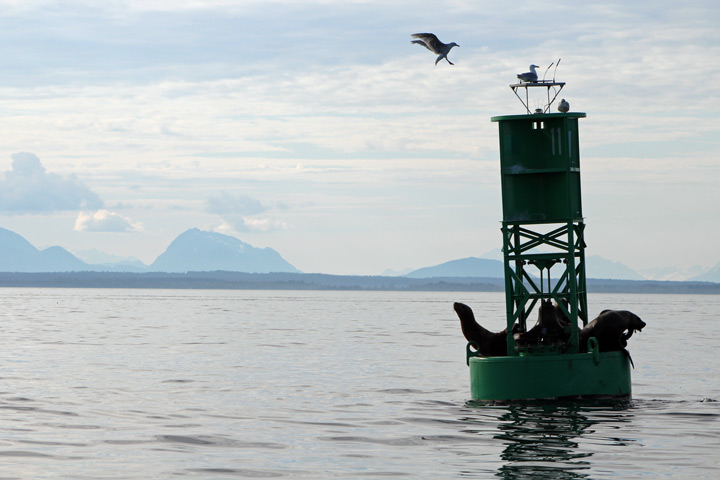
Stellar sea lions, chilling on a buoy in the waters of Icy Strait.
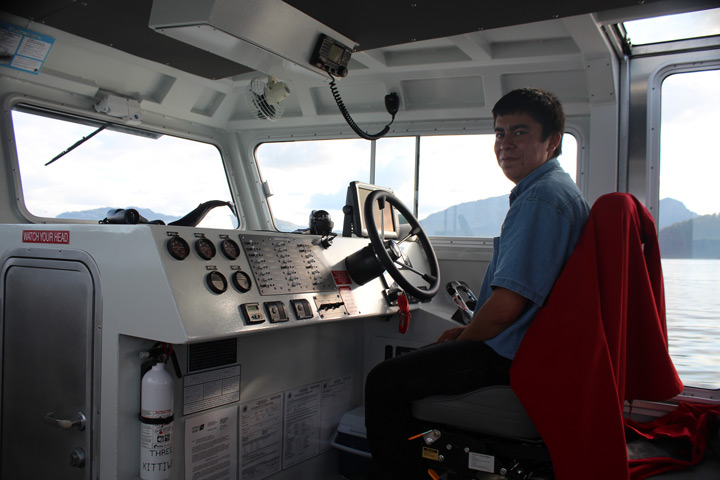
Our very young (and very good) whale-watching captain.
It was worth every penny, and if they had asked for $100 extra bucks to let us off the ship, it still would have been worth it. (They have a guarantee that you'll see one whale, and as a joke, they show you a small plastic whale model when you get on the boat. It's one of those jokes that's funnier after you've seen the actual whales.) The ship had maybe 20-25 tourists, and two excellent Tlingit guides. It was an uncle-nephew team, with the uncle serving as the naturalist, and the nephew piloting the boat. The nephew was maybe 18 and had just gotten his commercial captain's license; he had been sailing the waters of Icy Strait his entire life, and when we got to talking he told us he was a big Daniel Tosh fan. He had gone to high school in Hoonah, where his graduating class was 6 people. The uncle (who technically had to take orders from his nephew, but not really) had a wealth of knowledge about marine life, and also shared stories and photos of his family's fishing expeditions. Food is unpleasantly expensive in Alaska, because so many staples have to be imported at great cost. In a place like Hoonah where the economy is seasonal, they need cheap sources of food that can be preserved for a long time. Salmon fits that description, so the traditional fishing expeditions continue, albeit with some higher-tech gear.
They told us that the whale-watching expeditions earlier in the day had some success. They also told us that the whales would probably be hanging around. We headed for a location known as Dolphin Point, where a few bodies of water meet. That supposedly churns up the tiny marine creatures whose primary function is to serve as whale food. The humpbacks spend their summers in the waters of Alaska, eating ridiculous amounts and getting very fat. Then they head to the waters of Hawaii, where there's a lot less for them to eat. But it's a much more romantic location to bang.
I am happy to report that we watched the hell out of some whales. As we approached Dolphin Point, a few other ships were floating nearby, engines idle. That meant they were looking at something. Our captain stopped the boat and encouraged us to start scanning the horizon. We saw a few water spouts in the distance, and the humps of a few humpbacks skimmed the surface. The humps and spouts disappeared for a few minutes, and the captain was thinking about moving on ... at which point three whales appeared from below and came straight for us. They passed within a few feet of the boat; they circled around, swam at us, and passed directly under us. Our captain later confessed that he was terrified, because this hadn't happened to him before, and he wasn't sure exactly how he'd react if the whales hit the boat -- humpbacks can grow to about 45 feet, which is longer than the boat. A minute later, we saw the whales go into dives – which means they put their tails above water for your photographing pleasure. Whales are very big, and any time you can see a creature that size in its own environment, you should probably pee yourself a little bit and enjoy it.
The only dilemma was whether to stare through the camera or just watch. The holy grail of whale watching is a "breach," when the whale propels itself straight out of the water and flops over to make a giant splash. When you flopped at the YMCA, it was a horrible embarrassment that all the girls totally saw. When whales do it, they are hoping to churn the water and stir up more food. A breach takes only a few seconds, and if you're looking through a viewfinder there's a great chance you'll never find it in time. We already had plenty of amazing shots of whales menacing our boat, so I put the camera down ... and was able to react quickly enough to see a breach. It's amazing.
There were other animals, but "sea lion watching" doesn't sell tickets. We saw some Stellar sea lions playing on a buoy, and some otters hunting for fish. A few more bald eagles made an appearance, because this is Alaska and that's the law. But the whales were clearly the stars of the show, and our quest to see wildlife moved closer to an unqualified success. Especially when we heard that no one on the bear-watching tours saw a damn thing.
